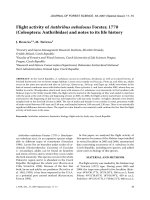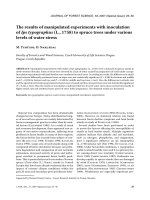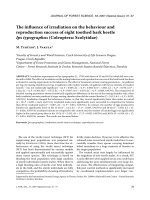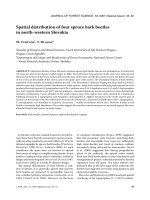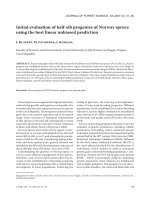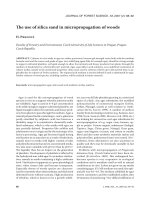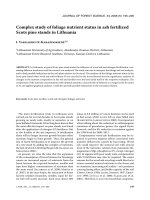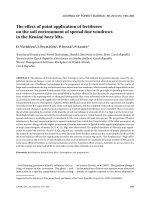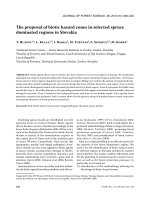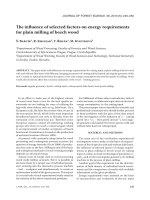Báo cáo lâm nghiệp: "Allozyme variation of Pinus pallasiana D. Don in Natural Crimean populations and in plantations in technogenously-polluted areas of the Ukraine steppes" ppsx
Bạn đang xem bản rút gọn của tài liệu. Xem và tải ngay bản đầy đủ của tài liệu tại đây (633.04 KB, 8 trang )
389
Ann. For. Sci. 61 (2004) 389–396
© INRA, EDP Sciences, 2004
DOI: 10.1051/forest:2004032
Original article
Allozyme variation of Pinus pallasiana D. Don in Natural Crimean
populations and in plantations in technogenously-polluted areas
of the Ukraine steppes
Ivan I. KORSHIKOV
a
*, Fulvio DUCCI
b
, Natalia S. TERLIGA
a
, Serguey A. BYCHKOV
a
,
Elizaveta M. GORLOVA
a
a
Dept. of Plant Tolerance Physiology, The Donetsk Botanical Gardens, Prospekt Ilyicha 110, Donetsk, 83059 Ukraine
b
Coordinator IUFRO WP 20213, Ist. Sperimentale per la Selvicoltura, C.R.A. – Council for Research and Experimentation in Agriculture,
viale S. Margherita 80, 52100 Arezzo, Italy
(Received 16 August 2002; accepted 6 November 2003)
Abstract – Allozyme variation parameters have been estimated and compared among four P. pallasiana D. Don plantations located in the
Ukraine steppes and in three Crimea natural populations. The analyses also concerned three groups of trees selected for their possible tolerance/
resistance to steppe conditions and to industrial pollution. The polymorphic loci percentage in the natural populations varied from 0.74 to 0.89
and the allele mean number varied from 2.4 to 2.7. Among the artificial plantations these values varied from 0.75 to 0.85 and from 2.35 to 2.75
respectively. Heterozygote deficiency (14.9%) was characteristic of 6 of the 7 stands examined. Instead, a heterozygote excess (14.6 to 36.9%),
but less allele diversity, was revealed among groups of selected trees. Nei’s genetic distances averaged to 0.010 when comparing natural and
artificial populations. Parameters measured on selected groups and on natural populations from the steppes showed an absence of inbreeding
depression. The results of this study lead to a recommendation that these trees be used as the basic material in extensive plantation programs of
P. pallasiana in the Ukraine steppes, including polluted areas.
Pinus pallasiana D. Don / Ukrainian steppe / allozyme variation / polluted areas / selection
Résumé – Variation alloenzymatique chez Pinus pallasiana de populations naturelles en Crimée et de peuplements plantés dans des
zones industrielles polluées de la steppe ukrainienne. Les paramètres de variation alloenzymatique de 4 peuplements de Pinus pallasiana
plantés dans la steppe ukrainienne de Pinus pallasiana et de 3 populations naturelles en Crimée ont été comparés. On a également analysé 3 groupes
d’arbres sélectionnés pour leur probable résistance/tolérance aux conditions de steppe et à la pollution industrielle. Le pourcentage de loci
polymorphes dans les populations naturelles varie de 0,74 à 0,89 et le nombre d’allèles de 2,4 à 2,7, alors que les valeurs relevées dans les
populations artificielles étaient respectivement de 0,75 à 0,85 et de 2,35 à 2,75. Six populations sur 7 ont montré un déficit d’hétérozygotie
(14,9 %) alors qu’un excès d’hétérozygotie (de 14,6 à 36,9 %) et une diversité allèlique réduite étaient notés dans les groupes d’arbres
sélectionnés. La distance génétique de Nei entre populations sélectionnées et populations naturelles est en moyenne de 0,1. Les paramètres
mesurés dans les différents types de populations n’ont pas révélé de dépression de consanguinité. Ces analyses permettent de recommander
l’utilisation, comme matériel de base, d’arbres sélectionnés pour entamer d’importants programmes de plantation de Pinus pallasiana dans la
steppe ukrainienne, y compris dans le zones atteintes par la pollution industrielle.
Pinus pallasiana D. Don / steppe ukrainienne / variation alloenzymatique / zones polluées / sélection
1. INTRODUCTION
The extensive group of Mediterranean and Balkan black
pines is a relict of the Tertiary era. One of these is the Pallas
pine, which several authors consider to be a sub-species, namely
Pinus nigra ssp. pallasiana (Lamb.), and it grows in the Cau-
casus and Balkan regions [25]. Debazac [6] divided this pine
into three varieties growing in different areas: var. pontica
Koch. in Crimea, var. caramanica Loud. in Anatolia and var.
Fenzeii Ant. and Ky on the Taurus range. Dallimore and Jackson
[7] had previously described these three varieties as synonyms
of P. nigra var. caramanica (Loudon) Rehder. The Crimean
sub-species of black pine that has been widely used for affor-
estation programs in the Ukraine steppes is considered in this
paper.
The usual explanation of the lack of forests or absence of exten-
sive forests in the Ukraine steppes, an area of 240 000 square
kilometres, is related to the particular ecological conditions
found there. The region is characterised by steppe phytocoe-
noses [2], fertile black soils (6–9% humus content) and an arid
* Corresponding author:
390 I.I. Korshikov et al.
continental climate receiving 300–450 mm of mean annual
rainfall. In this environment, forestation has always been a dif-
ficult and complicated task [2, 21]. In the final decades of the
20th century afforestation programmes were started using
P. pallasiana from Crimea, whose adaptive potential was well
known to the local foresters. The comparatively good plasticity
of this species can be explained by its relatively high genetic
variation levels, which were observed by Silin and Goncharenko
[22] and which they found also within the Crimea populations.
They defined this pine as one of the most variable within the
genus Pinus.
Moreover, most of the afforestation programs were carried
out in the southern steppe regions of Ukraine, thereby excee-
ding the range of Crimean natural populations [3].
Natural basic materials are generally considered to have the
potential to supply seeds and seedlings with sufficient genetic
diversity parameters but, in any case, monitoring these param-
eters and any possible genetic losses is of great importance for
the conservation and sustainability of the artificial stands. Sev-
eral selection factors may affect a lot of the propagation mate-
rials used in afforestation programs and some of the most focal
usually considered are extreme climatic conditions and stand-
ard nursery practices. This second factor, especially, can often
be of great importance, along with the nursery networks.
Indeed, unsuitable seedlings are usually screened and rejected
before distribution and this might result in dramatic changes to the
original genetic structure of the propagation material. Moreo-
ver, the Pinus pallasiana considered by us was used in a steppe
environment with a very extreme climate. These steppe plan-
tations were often included in polluted urban and industrial
areas, where the selection pressure can be chronically strong
[14]. As a consequence, the structural and genetic parameters
of populations growing in steppe and polluted environments
could have worsened when compared to other natural and arti-
ficial populations. Changes due to air and soil pollution were
also detected in the gene pool structures of forest species by
Bergmann and Scholz [5], by Geburek and Scholz [9] and by
Bergmann and Hosius [4]. Geburek et al. [10] compared Pinus
sylvestris trees which were tolerant and sensitive to air pollu-
tion. They investigated possible isozyme gene loci involved in
sensitivity against environmental stress and found a strong
selection effect. For the same species, Korshikov et al. [15] con-
firmed the occurrence of selection pressure determined by pol-
lution on the genetic structure of populations.
By using isozyme analysis, a selection effect by air pollution
on gene pools of different species (Silver fir, Norway spruce,
and European beech) was also demonstrated by Longauer et al.
[17] and by Müller-Starck [19].
Given these earlier results, it is clearly important that, before
selection and improvement programs go ahead [3, 13], the
genetic potential of possible basic materials needs to be investiga-
ted and compared to a reference system of natural populations.
This comparison can also be very important in the case of
Pinus pallasiana, in order to monitor the effects of selection
pressure on basic materials, due not only to climatically extreme
and polluted conditions, but also to the effects of the selection/
improvement carried out by foresters.
The specific goal of this investigation was to compare the
allozyme variation parameters of a P. pallasiana natural reference
system, namely the Crimean natural populations, with artificial
stands growing in environments suffering from various forms
of pollution, with a view to further selection and improvement.
This contribution reinforces and enhances the methods used in
Ukraine for selecting basic materials tolerant/resistant to pollution.
2. MATERIALS AND METHODS
2.1. Plant material
The genetic parameters of ten sub-populations (Tab. I), belonging
to three larger P. pallasiana Ukraine natural and artificial prove-
nances, were compared. The comparison method was based on the
common homeostatic principle that a higher degree of individual
genetic multiplicity supports higher viability [16]. On this basis it
would be assumed that large natural populations provide both a source
of this multiplicity and a reference system for monitoring diversity
within artificial populations.
Artificial pine populations of the Ukraine steppe and groups of trees
selected within natural and artificial populations were compared to a
reference system of natural Crimean stands in order to determine pos-
sible losses of genetic diversity.
The main locations of the larger provenances (Fig. 1 and Tab. I)
are: (a) the southern macro-slope of the main range of the Crimea
mountains, 3 natural stands coded C; (b) the Ukraine steppe near the
town of Mariupol, close to the Azov Sea coast, 2 stands coded An; and
(c) the interior steppe near the town of Krivorozhje, 2 stands coded Kn.
All the artificial populations were certified by the local forest services
as provenances from Crimea and their main characteristics are sum-
marised in Table I.
Figure 1. Location of Black Pine natural stands and plantations exa-
mined (see also Tab. I).
The Crimean black pine in polluted areas 391
The Crimean natural reference system was formed by trees aged
from 80 to 120 years old and over. Provenances were sampled at dif-
ferent ranges of elevation and slope aspect: 400–900 m, eastern slope,
Nikita (C
1
); 400–1200 m, southern slope, Iograph Mountain (C
2
); and
400–1200 m, western slope, Alupka (C
3
).
Populations C1 (Nikita) and C2 (Iograph) belong to the same set
of 8 natural stands studied by Silin and Goncharenko [22]. However,
only for C2 was there clear correspondence among the sampled pop-
ulations, whilst our C1 included both the populations which they had
named Nikita 1 and Nikita 2.
The Azov Sea plantations are exposed to both sporadic (A
1
) and
chronic (A
2
) emissions released by the largest metallurgical plants in
Europe. On the other hand, the plantations sampled in the Krivorozhje
region are located on mining dumps, dealing with thermal treatment
of iron-ore and metal smelting (K
2
), and on a recreation area in Krivoy
Rog (K
1
), where pollution is mostly of urban origin. The trees in K1
are more than 40 years old and those in K2 aged approximately
20 years.
Between 1995 and 1999 a selection programme for tolerance/
resistance to air and soil pollutants was started across A1, A,2, K1 and
K2. As a result of this screening, 20 trees, possibly the most tolerant
to air pollutants, were selected within the Azov Sea coast populations
and 20, possibly the most tolerant to urban pollution and to soils con-
taining heavy metals, were selected across the Krivorozhje stands.
Selection was made by using phenotypic indicators (i.e. growth, vig-
our, health of crowns etc.) and the selected populations were coded
TA and TK for the Azov and Krivorozhje regions respectively. The
selected trees were characterised by their relatively high seed produc-
tion and their high germinating capacity of seeds (70–90%). They were
considered to offer a possibly good genetic base for further improve-
ment and breeding.
At the same time a set of 20 plus trees across the Crimean natural
populations was selected phenotypically according to traditional
parameters (vigour, stem form etc.) and grafted to establish a clonal
seed orchard. These clones were considered as a selected reference
population and coded TC.
The genetic variation was estimated by isozyme marker analysis
performed on all the populations mentioned above.
2.2. Allozyme analysis
At least 5 cones per tree were collected from 429 pine trees to
extract seeds for electrophoretic analysis.
Enzymes were extracted from haploid mega-gametophytes using
an 0.15 M Tris-glycine pH 8.3 buffer, containing 0.003 M ethylen-
diamin-tetracetate disodium salt, 0.002 M diethyl-ditio-carbamic acid
disodium salt and 0.003 M dithio-threitol. The homogenates were used
in electrophoresis in 7.5% polyacrylamid gel vertical plates (pH 8.9)
using a Tris-glycine electrode buffer (pH 8.3).
The enzyme activity zones were stained according to Korochkin
et al. [12], Goncharenko et al. [11], with insignificant modifications.
Nine enzyme systems were analyzed: alcohol dehydrogenase (ADH,
E. C. 1.1.1.1), aspartate-amino-tranferase (AAT, E. C. 2.6.1.1), gluta-
mate-dehydrogenase (GDH, E. C. 1.4.1.2), diaphorase (DIA, E. C.
1.6.4.3), malate-dehydrogenase (MDH, E. C. 1.1.1.37), superoxide-
desmutase (SOD, E. C. 1.15.1.1), acid phosphatase (ACP, E. C.
3.1.3.2), leucine-amino-peptidase (LAP, E. C. 3.4.11.1) and formiat-
dehydrogenase (FDH, E. C. 1.2.1.2). On average 8 endosperms per
tree were analysed, and 16 endosperms in the case of homozygous gen-
otypes. Allelic variants were revealed by the analysis of their segre-
gation in haploid mega-gametophytes of heterozygous trees [8].
2.3. Statistical analysis
The genetic variation was assessed by the most frequently used sta-
tistical parameters for population-genetic analysis and computed by
using Biosys-1.7 software [24]: allelic richness (n. a.), allele frequen-
cies (a. f.), percentage of polymorphic loci after 99% criterion (P%),
mean number of alleles per locus (n.), values of observed (Ho) and
expected heterozygosity (He), Wright’s F-statistics and Nei’s G-sta-
tistics parameters, and Nei’s [14] genetic distance coefficient. The
standard χ
2
test was also used to assess the allelic heterogeneity and
this parameter was assessed by comparing the larger pooled prove-
nances with each single group of selected trees (namely TC, TA, TK).
Indeed, these groups were selected by foresters across the larger prov-
enances and not within separated stands.
3. RESULTS
3.1. General aspects
The total number of loci examined was 20, of which 18 were
polymorphic.
Loci S
OD-2 and SOD-3 proved to be monomorphic in all the
samples of P. pallasiana studied, and variation for locus S
OD-1
was noted in C
3
only (Alupka).
Table I. Mean traits of Pinus pallasiana examined populations (see also Fig. 1).
Code Region Population name Origin Pollution Purpose No. of sampled trees
A1 Azov Coast Mariupol 1 Crimea Gas, sporadic Steppe re-afforestation 55
A2 Azov Coast Mariupol 2 Crimea Gas, chronic Steppe re-afforestation 50
TA Azov Selected trees Crimea Yes Tolerance to pollution 20
C1 Crimea Nikita Eastern Crimea, 400–900 m No Natural population 76
C2 Crimea Iograph Central Crimea,
400–1200 m
No Natural population 51
C3 Crimea Alupka Western Crimea,
400–1200 m
No Natural population 37
TC Crimea Selected trees Crimea No Clonal seed orchard 20
K1 Krivorozhje Mines Ukraine Chronic, soil
heavy metals
Wasted area afforestation 50
K2 Krivorozhje Krivoy Rog Ukraine Urban, lower level Ricreational area 50
TK Krivorozhje Selected trees Crimea Yes Tolerance to pollution 20
392 I.I. Korshikov et al.
As a result of the analysis of 9 enzyme systems in the pooled
sampling of 429 P. pallasiana trees, 73 electrophoretic allelic
variants were revealed, 49 of which were shared by the popu-
lations examined.
Most of the alleles of polymorphic loci were common to the
overwhelming majority of P. pallasiana samples analysed.
With the exception of loci A
AT-2 and MDH-4, the most com-
mon alleles had frequencies higher than 0.500.
As could be reasonably expected, the greatest richness of
allelic variants (Tab. II) should have been among the Crimean
provenances. However, this was observed only when both the
Crimea and Azov Sea coast materials were compared. Indeed,
the Krivorozhje populations (K1 and K2) showed an average
richness greater than the other groups of populations.
The selected groups of trees (TA, TC, TK) also showed the
same respective trends and ranking in richness. In any case, a
general loss of alleles was evident everywhere within those
populations.
The distribution of rarer alleles was, in general, similar
across all the examined provenances. On average about 30%
of the allelic richness was to be considered rare (Tab. II). Rare
alleles were revealed within each of the three geographical
areas. Three rare alleles were only recorded in the Crimea popu-
lations, whilst one was found in the Azov plantation and four
in the Krivorozhje plantation. No rare alleles typical of these
groups were found within the three groups of selected trees
(TA, TK, TC). With regard to the amount of rarer alleles, no
wide differences were noted between TA and TC, whilst TK
showed the largest amount of allelic variants to be noted as rare.
3.2. The natural reference system and the artificial
populations
The allele frequencies and heterozygosity (Tab. III) showed
an absence of geographical trends among the natural popula-
tions and the plantations.
The percentage of polymorphic loci varied from 0.74 to 0.89
in the Crimea natural populations. The mean number of alleles
varied from 2.42 to 2.74.
These parameters did not vary, or varied only in a very nar-
row range, within the artificial plantations of the Azov Sea
coast (A
n
) and Krivorozhje (K
n
) and generally presented good
characteristics compared to the natural populations.
The heterozygosity of the most variable loci M
DH-3, DIA-4,
G
OT-2, DIA-1, ACP and of the less variable SOD-1, AAT-1,
M
DH-2, GDH, varied in a stochastic way across all the popula-
tions.
Divergences from the Hardy-Weinberg equilibrium were
significant for C1, C3, A1, A2 and K2 (Tab. III).
All cases of significant divergences from the Hardy-Weinberg
equilibrium have to be related to a deficiency of heterozygotes
(Tabs. III and IV). It is notable that the unbalanced distribution
of genotypes in locus M
DH-4 is characteristic across all the stu-
died pine populations, including the clonal seed orchard (TC).
The values of observed and expected heterozygosity were
only slightly different in the natural populations of P. pallasi-
ana studied in Crimea. In these populations the mean value of
the observed heterozygosity (Ho = 0.20) was 20.5% lower than
the value recorded after Silin and Goncharenko [22]. In one of the
Azov plantations (A2) and one of the Krivorozhje plantations
(K2), the values of Ho found were similar to the natural popu-
lations. In the other Azov plantation, A
1,
these values were sig-
nificantly lower than in two out of the three natural populations
(C1 and C2). In K2
,
instead, they were higher than these pop-
ulations. The mean expected heterozygosity was 12.7% lower
(He = 0.22) in the studied populations than in the earlier studies
[22]. Significant differences in He were found for the Azov Sea
coast plantation A
1
only when these were compared to the nat-
ural populations.
The structure analysis of the P. pallasiana natural and arti-
ficial populations was carried out using Wright’s F-statistics
and Nei’s G-statistics. Both these indices indicated a deficiency
Table II. Synthesis of the allelic richness and rare allele distribution across the population examined.
Region and
population code
Total No. of alleles detected
within population
Averaged No.
per region
Differences compared
to the region average %
Rare alleles
(frequency 0.05)
% of rare alleles on the
total No. of alleles
Azof Sea coast 48
A1 46 15 32
A2 50 17 34
TA 41 –7 6 14
Crimea 51
C1 54 17 31
C2 51 18 35
C3 48 13 27
TC 39 –30 5 12
Krivorozhje 54
K1 54 18 33
K2 54 14 25
TK 48 –12 12 25
The Crimean black pine in polluted areas 393
of heterozygotes in most of the examined populations. Signif-
icant deficiencies of heterozygotes, from 11.6 to 14.9%, were
noted within the natural populations C1 and C3 and in three arti-
ficial stands (A1, A2 and K2). When the fixation indices were
pooled according to the greater regions (Tab. V), the highest
heterozygosity deficiency was observed in the Azov Sea coast
populations and Crimea populations (7.1% and 6.6% respec-
tively), whilst the best situation was noted in the other set of
artificial populations in the Krivorozhje region where the defi-
ciency was only 2%. The differences between Krivorozhje and
the others were thus significant (Tab. V). Genetic differentia-
tion of the populations and plantations investigated was low,
as shown by the small values of Fst, Gst and Nei’s [20] genetic
distance (D
N
) coefficients. In Crimea, D
N
varied within the
range of 0.004 to 0.012 and averaged to 0.009 (Fig. 2). This
coefficient varied within a rather narrow range (0.006 to 0.017,
averaged to 0.010) when the Cn natural populations were com-
pared to the Azov and Krivorozhje plantations respectively.
This analysis showed that most of the P. pallasiana plantations
of the steppes (A
1
, A
2
, K
2
) retain the essential genetic diversity
that occurs within the natural pine populations of Crimea.
3.3. The selected populations
As could be reasonably expected, the selection of tolerant/
resistant trees and their small number, only 20 per provenance
(TA, TC, TK), resulted in a loss of alleles. The clonal seed
orchard established with plus trees selected from the Crimea
populations (TC) showed the lowest number of alleles (39).
This was lower than the number in the selected population TA
from the Azov Sea coast (41 alleles) and in the other population
TK from Krivorozhje (48 alleles). These groups of selected
trees showed a general trend to change the expected heterozygosity
for some loci (i.e. M
DH-4 and DIA-2) compared to the original
populations. Values of He for M
DH-4 were about 1.9 times higher
when TC was compared to the Crimea populations (C1, C2,
C3), from 1.9 to 4.8 times when TA was compared to the Azov
plantations (A1, A2), and from 1.6 to 1.8 times when TK was
compared to Krivorozhje plantations (K1, K2). On the con-
trary, values for D
IA-2 were about 2.6 times lower when TC
Table III. Values of the main genetic parameters in Crimea P. pallasiana natural populations, steppe Ukrainian plantations and selected
groups.
Stand n. t. (P
0,99
) n.
Mean heterozygosity
FIS
(H
0
)(H
e
)
C1 76 0.737 2.737 0.205
(0.018)
0.232
(0.020)
0.116***
C2 51 0.737 2.474 0.202
(0.022)
0.209
(0.022)
0.033
C3 37 0.895 2.421 0.188
(0.26)
0.217
(0.028)
0.134***
TC. clones* 20 0.700 2.000 0.235
(0.032)
0.220
(0.034)
–0.068
A1 55 0.750 2.350 0.157
(0.020)
0.175
(0.020)
0.103***
A2 50 0.750 2.550 0.185
(0.022)
0.217
(0.024)
0.147***
TA. selected trees** 20 0.750 2.150 0.215
(0.036)
0.227
(0.038)
0.053
K1 50 0.850 2.750 0.251
(0.024)
0.239
(0.024)
–0.050
K2 50 0.800 2.700 0.194
(0.022)
0.228
(0.024)
0.149***
TK. selected trees** 20 0.850 2.450 0.210
(0.038)
0.225
(0.038)
0.067
* Phenotypically selected; ** selected as tolerant/resistant to pollution; n. t.: number of trees; P
0,99
:
percentage of polymorphic loci; n.: mean number
of alleles per locus; FIS: Wright’s fixation index (coefficient of inbreeding) computed as FIS = 1 – H
0
/H
e
, significant deficiency or excess of heterozy-
gotes (P < 0.01) are marked ***.
Figure 2. Cluster dendrogram based on Nei’s genetic distances [10]
measured between P. pallasiana samples.
394 I.I. Korshikov et al.
was compared to C1, C2
and C3, from 15 to 2.4 times lower
when TA was compared to A1
and A2, and 18 times lower when
TK was compared to K
1
and K
2
.
Allele heterogeneity was observed within the three natural
populations of Crimea P. pallasiana (C1, C2, C3) for 4 loci
(Tab. IV). The same was observed when the artificial popula-
tions of the Azov Sea coast were examined. Heterogeneity in
the Krivorozhje plantations was reduced to 3 loci.
Heterogeneity with significant differences was mainly
observed for locus M
DH-4 (Tab. IV). This was evident when
the selected groups TC, TA, TK were pooled. The two selected
populations from Azov and from Krivoroje showed polymor-
phic loci percentages relatively similar to the provenances they
were selected from, whilst in TC the value was relatively lower.
On the other hand, the mean number of alleles was notably
lower: from 18.4 to 27% in TC, from 9.5 to 15.7% in TA coast
and from 9.3 to 11% in TK (Tab. III). The level of heterozygo-
sity was very similar in all the P. pallasiana stands, with the
exception of the Azov Sea coast materials which seemed gene-
tically poorer. Values of Ho were 14.4 to 25% higher in TC than
in the Crimea natural populations. Ho was significantly higher
in TA than in the Azov Sea coast plantations (A
1
, A
2
) and the
values were higher than those supplied earlier for this area [14].
Excess of heterozygotes, even if not significant (6.8%), was
noted in TC only. Within TA and TK, however, a lower defi-
ciency of heterozygotes was found than in their original stands.
Values of Ho (9.3 to 11.9%) and in particular He (2.3 to 3.2%)
observed in the selected populations were notably lower than
in their stands.
The degree of genetic differentiation of selected groups (TC,
TA, TK) and of plantations (A1, A2 and K1, K2) was lower
than the natural populations of P. pallasiana (C1, C2, C3). Con-
sequently, values of the genetic distance coefficient D
N
varied
from 0.009 to 0.024 (average: 0.015) between TC and C1, C2,
C3. The groups of selected trees (TC, TK, TA) were relatively
diverged (D
N
= 0.017 to 0.035, mean 0.026) (Fig. 2).
4. DISCUSSION AND CONCLUSION
The variation characteristics outlined for P. pallasiana natu-
ral populations by this study differed from those after Silin and
Goncharenko [22]. Indeed, only two of our reference system
populations can be considered common to these authors. On
one hand, the wider number of natural populations they exa-
mined may have contributed to their finding greater genetic
variation across Crimea. No problem should arise from the
number of trees per population which we have sampled. Indeed,
while the number of samples was similar to Silin and Goncha-
renko [20] for Nikita, it was double for our work in Iograph.
On the other hand, even if the larger number of loci examined
by these authors could have contributed to detecting more
variation, the acrilamide gel electrophoresis that we used
improved the detection of at least 54 alleles/18 loci. The starch
gel system used earlier by these authors allowed a ratio of
55 alleles/20 loci.
The values of the main genetic parameters detected by us for
C2 (Iograph) were relatively close to the earlier studies, whilst
Nikita (C1) showed a significant excess of homozygotes. This
unbalanced state, which we observed in Nikita, may be more
reasonably explained by the mature age of the trees sampled.
Other demographic factors, difficult to evaluate in this analysis,
probably also played a role. Moreover, the progressive reduction
and fragmentation of the range could have induced the high within-
population variation detected by Silin and Goncharenko [22].
The genetic variation of conifers is generally lower in arti-
ficial stands than in natural populations, [1, 18, 22]. This com-
parative investigation within the Crimean P. pallasiana showed
the ability of some artificial populations (Kn, Ukrainian steppe)
Table IV. Comparative analysis of alleles heterogeneity after a χ
2
criterion within the P. pallasiana natural populations, artificial stands and
selected materials. Monomorphic loci were excluded from the table.
Locus Pooled Crimean
natural populations
C1, C2, C3
Crimean Provenance plantations The selection group of plants – original populations and plantations
Pooled Azov sea
coast A1, A2
Pooled Krivorozhje
K1, K2
Crimea
TC
Azov Sea coast
TA
Krivorozhje
TK
Pooled
TC, TA, TK
Got-1 8.77* (2) n.s. n.s. n.s. n.s. n.s. n.s.
Mdh-4 23.75** (8) 23.48*** (4) 29.67*** (4) 18.73*** (4) n.s. n.s. 16.56* (6)
Dia-1 16.03** (6) n.s. n.s. n.s. n.s. 7.80* (2) n.s.
Dia-4 n.s. n.s. 6.5* (2) n.s. n.s. n.s. n.s.
Acp n.s. 9.84* (3) n.s. 16.40*** (3) n.s. n.s. n.s.
Adh-1 12.67** (6) 13.61** (4) n.s. n.s. n.s. n.s. n.s.
Adh-2 n.s. n.s. 11.44** (3) n.s. n.s. n.s. n.s.
Fdh n.s. 14.24** (3) n.s. n.s. 6.65* (2) n.s. n.s.
Multilocus estimation 121.06** (88) 98.29*** (48) 100.67*** (52) 60.01 (45) 30.55 (34) 46.04 (46) 82.74 (68)
* Significance level of 95%, ** significance level of 99%, *** significance level of 99.9%, a number of degrees of freedom is stated in brackets.
Table V. Mean values of Wright’s F- and Nei’s G-parameters for the
Crimean P. pallasiana natural populations and plantations.
Provenance F
is
F
it
F
st
G
st
Crimean populations 0.066 0.077 0.013 0.016
Azov sea coast plantations 0.071 0.078 0.007 0.011
Krivorozhje plantations 0.020 0.028 0.009 0.010
The Crimean black pine in polluted areas 395
to preserve better the potential of their natural provenance pop-
ulations. Several considerations need to be made with regard
to the generally better situation presented by the Krivorozhje
provenance. This could depend on a more efficient seed collection
organisation, as well as a full ripening period for fructification
in the original stands. In addition, the original genetic structure
of the basic materials could have played a role in establishing
the suitable variation status detected within. Such positive
effects on artificial population genetic structures are not usually
always possible. Very often selection factors of a natural or
human origin can greatly modify the genetic parameters. Var-
iation can be depressed by these factors, as shown by Müller-
Starck [19] for natural beech populations in Germany, and by
Geburek et al. in Pinus sylvestris trials [10]. This situation was
also outlined by Bergmann and Scholz [5] for Norway spruce
and by Longauer et al. [17] for Norway spruce, European silver
fir and beech. Korshikov et al. [15] also found in Pinus sylves-
tris a slightly lower level of genetic diversity in damaged pop-
ulations than in populations not exposed to the effects of pol-
lutants.
No relationships were found through our work for A
AT and
G
DH with sensitivity or resistance to air pollution, as suggested
by Geburek et al. [10].
Even though structurally unbalanced, the Azov sea coast
provenances showed almost similar polymorphism to the natu-
ral populations of Crimea. Lower diversity values in this popu-
lation could arise from several environmental factors, both
natural and caused by pollution, near the plantation site, as well
as possible differences in seed quality as determined by the year
of collection, the number of sampled trees and so on.
All our results agree with the higher ecological plasticity of
P. pallasiana as suggested by Korshikov [13]. The Pallas pine
shows generally good ability to preserve its original variation
and structure in artificial stands, even when under strong selec-
tive pressure due to pollution. This was also partially true after
strict criteria were used for selecting plus trees or possibly tole-
rant/resistant phenotypes. Selected populations showed a
reduction in their variation compared to their respective pro-
venance. Indeed, it was evident that the number of alleles was
generally lower in TC, TA, and TK. The reduction of rarer alle-
les was evident in these sub-populations: about three times in
TC and TA, only once in TK. This reduction was probably due
to several factors, such as the size of the selected populations
and/or the selection effect on some alleles, as previously demons-
trated by a number of authors [5, 10, 13–15, 23]. Nevertheless,
the genetic structure of these selected materials, as shown by
Wright’s FIS, was relatively better and more balanced when
compared to their provenances. This would agree with other
experiences where greater allelic diversity and higher levels of
expected heterozygosity were recorded by some researchers in
seed orchards when compared to natural populations [18, 23].
If we assume heterozygosity is the best possible tool for the
sustainability of artificial populations [16], collecting seeds or
selecting superior phenotypes in populations where deficiency
of heterozygosity was noted can adversely affect the genetic
structure of their offspring. In the same way, the excess of hete-
rozygotes revealed in TC, as well as in K1, will reduce possible
risks of inbreeding depression in seed posterity.
Although a general reduction of genetic diversity was found
across all the groups of selected trees, the original diversity was
essentially preserved. Moreover, the good genetic variation
levels preserved in the plantations showed the relatively good
quality of the nursery supply system used in Ukraine for P. pal-
lasiana.
As a consequence of this study, it is clear that the selected
materials TC, TA and TK can be considered as relatively good
basic materials for establishing a seed orchard network pro-
gramme. The main aim will be to produce propagation mate-
rials that are more tolerant to the adverse conditions of the
Ukrainian steppes, as well as to provide seedlings for urban
forestry programs in badly polluted industrial areas.
Acknowledgements: This paper was in the framework of IUFRO
WP20213. The authors wish to thank the anonymous referees for
their valuable review and Dr. Eric Teissier du Cros, IUFRO’s vice
President for Science for suggestions, comments and for his support
to this activity.
REFERENCES
[1] Adams W.T., Joly R.J., Allozyme studies in loblolly pine seed
orchards: clonal variation and frequency of progeny due to self-fer-
tilization, Silvae Genet. 29 (1980) 1–4.
[2] Belghardt A.L., Forest reproduction in the steppe zone, M. Lesnaya
promyshlennost’, 1971, 336 p. (in Russian).
[3] Beloborodov V.M., Shiryaev V.I., Patlay I.N., Introduced units in
the forest cultures of the country’s European part, Lesnoye kho-
ziaystvo 8–9 (1992) 38–39 (in Russian).
[4] Bergmann F., Hosius B., Effect of heavy-metal polluted soils on the
genetic structure of Norway spruce seedling populations, Water,
Air Soil Pollut. 89 (1996) 363–373.
[5] Bergmann F., Scholz F., The impact of air pollution on the genetic
structure of Norway spruce, Silvae Genet. 36 (1987) 80–83.
[6] Debazac E.F., Manuel des Conifères, Engref, Nancy, 1977, pp. 96–97.
[7] Dallimore W., Jackson A.B., A Handbook of Conifers. Edward
Arnold Publishers Ltd., London, 1961, pp. 514–517.
[8] Eckert R.T., Joly R.J., Neale D.B., Genetics of allozyme variants
and linkage relationships among allozyme loci in 35 eastern white
pine clones, Can. J. For. Res. 11 (1981) 573–579.
[9] Geburek T., Scholz F., Über Selektionwirkungen bei Forstpflan-
zenpopulationen infolge von Luftverunreinigungen, Forstarchiv 56
(1995) 234–238.
[10] Geburek T., Scholz F., Knabe W., Vornweg A., Genetic studies by
isozyme gene loci on tolerance and sensitivity in air polluted Pinus
sylvestris field trial, Silvae Genet. 36 (1987) 49–53.
[11] Goncharenko G.G., Padutov V.E., Potenko V.V., Guidelines on
studying the conifers using enzyme electrophoresis analysis,
Homel (l), 1989 (in Russian).
[12] Korockin L.I., Serov O.L., Pudovkin A.I., Genetic of Isozymes,
Nauca, Moscow, 1977, 278 p. (in Russian).
[13] Korshikov I.I., Plants adaptation to the technogenously polluted
environment conditions, Naukova dumka, Kiev, 1996 (in Russian).
[14] Korshikov I.I., Bychkov S.A., Comparative analysis of genetic
variation in 2 groups of P. pallasiana trees, differing in the degree
of injury due to the pollutants in the city of Mariupol plantations,
Cytol. Genet. 35 (2001) 30–35.
[15] Korshikov I.I., Velikoridko T.I., Butilskaya L.A., Genetic structure
and variation in Pinus sylvestris L. population degrading due to pol-
lution-induced injury, Silvae Genet. 36 (2002) 45–49.
[16] Lerner I.M., Genetic homeostasys, Oliver and Boyd, Edinbourgh,
1954.
396 I.I. Korshikov et al.
[17] Longauer R., Gömöry D., Paule L., Karnosky D.F., Manikovska B.,
Müller-Starck G., Percy K., Szaro R., Selection effects of air pollu-
tion on gene pools of Norway spruce, European silver fir and Euro-
pean beech, Environ. Pollut. 115 (2001) 405–411.
[18] Moran G.F., Bell J.C., Matheson A.C., The genetic structure and
levels of inbreeding in a Pinus radiata D. Don seed orchard, Silvae
Genet. 29 (1980) 190–193.
[19] Müller-Starck G., Genetic differences between “tolerantaù” and
“sensitive” beeches (Fagus sylvatica L.) in an environmentally
stressed adult forest stand, Silvae Genet. 134 (1985) 241–247.
[20] Nei M., Genetic distance between populations, Amer. Naturalist
106 (1972) 283–292.
[21] Paschenko V.M., The steppe zone. The nature of the Ukrainian SSR
– Landscapes and physical and geographic regionalization,
Naukova dumka, Kiev, 1985, pp. 122–179 (in Russian).
[22] Silin A.E., Goncharenko G.G., Allozyme variation in natural popu-
lations of Eurasian pines. 4. Population structure and genetic varia-
tion in geographically related and isolated populations of Pinus
nigra Arnold on the Crimean peninsula, Silvae Genet. 45 (1996)
67–75.
[23] Shigapov Z.H., A comparative genetic analysis of forest seed
orchards (plantations) and natural populations of scotch pine (Pinus
sylvestris L.), Lesovedeniye 3 (1995) 9–24 (in Russian).
[24] Swofford D.L., Selander R.B., Biosys-1, release 1.7, A computer
program for the Analysis of Allelic Variation in Population Genet-
ics and Biochemical Systematics ©, Swofford D.L., Illinois Natural
History Survey, 1989.
[25] Vidakovic M., Conifers. Morphology and variation, Ed. Boro Bre-
kalo, Zagreb, 1991, pp. 496–498.
To access this journal online:
www.edpsciences.org
